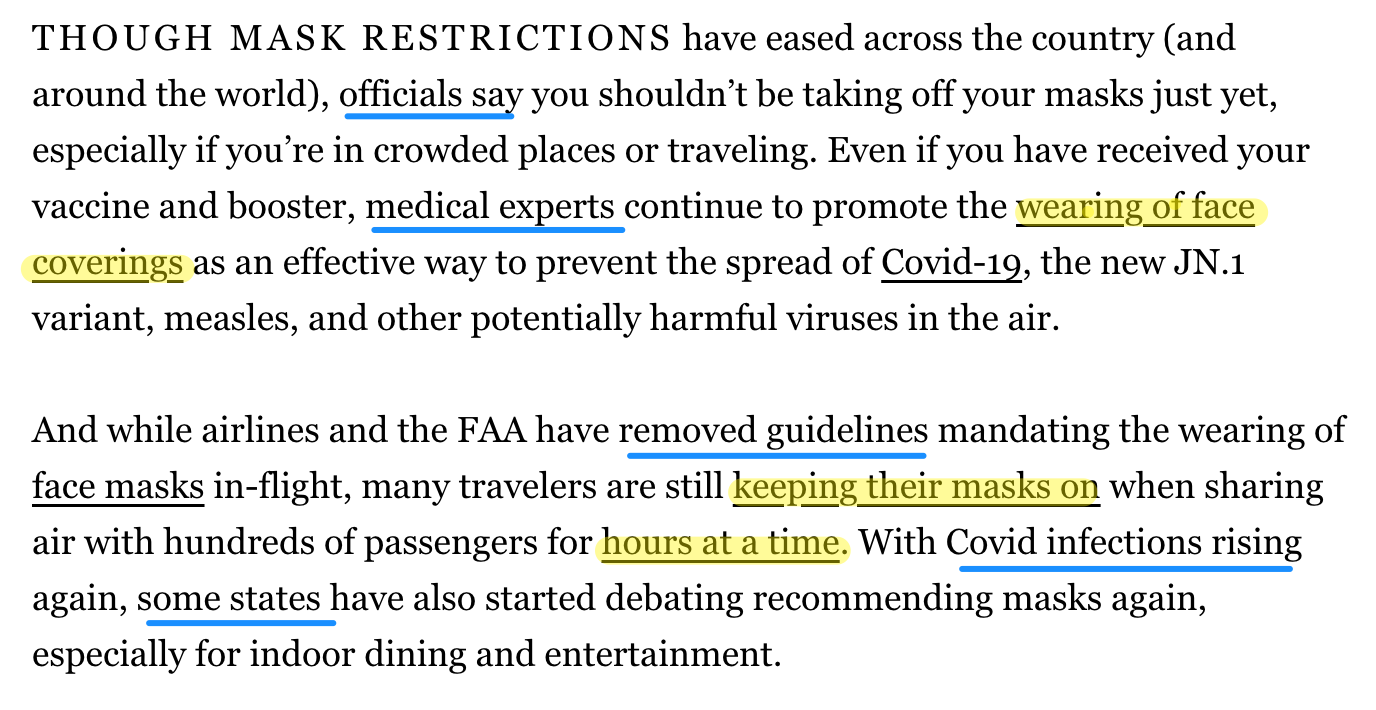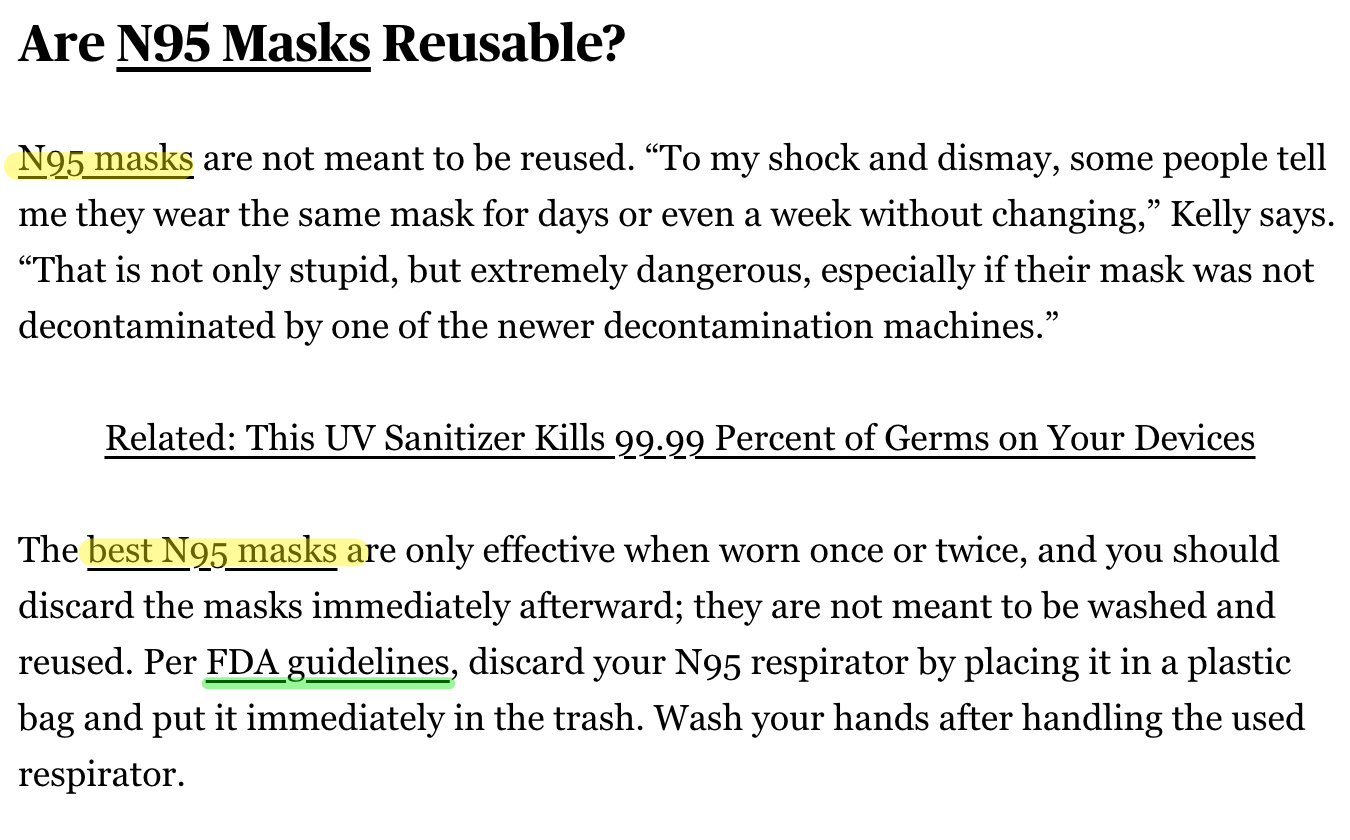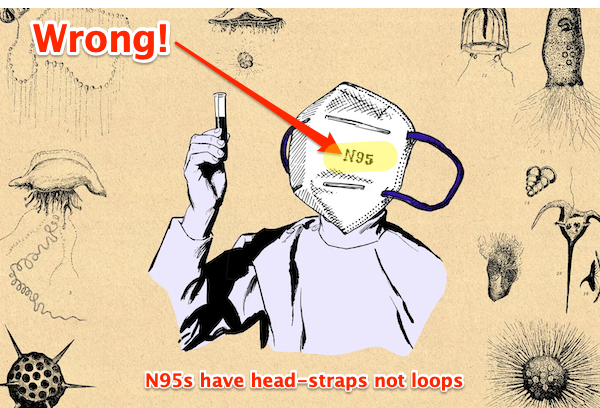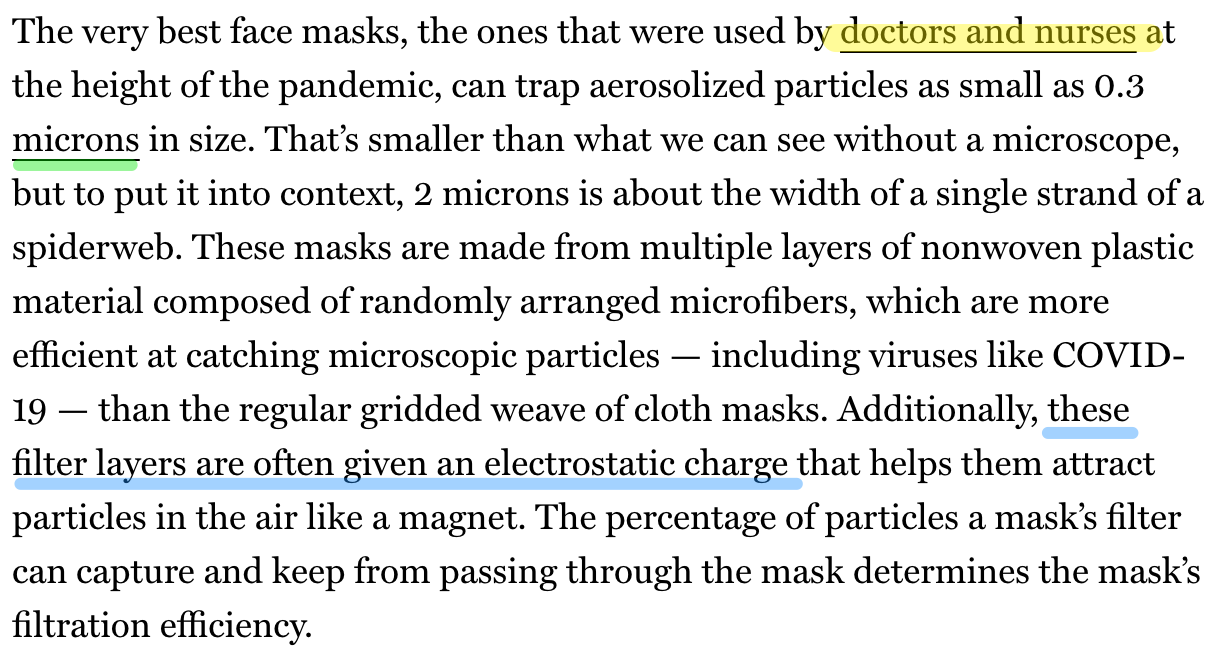Rolling Stone and New York Magazine Both Publish Product Reviews of Masks (But Not Reporting, Unfortunately)

By Lambert Strether of Corrente.
Patient readers, this may not be as thorough and tenacious a post as I would like; I have some sort of muscle spasm in my upper back, which isn’t yielding to treatment at all, and makes it hard to type for extended periods. So we’ll see. Some linky goodness may be sacrificed. –lambert UPDATE Found the heating pad, and hydrating. Nevertheless!
Here are the two articles:
(New York Magazine’s article is from “The Strategist,” a site under their umbrella, which I confess is a guilty pleasure of mine. It’s about “intelligent shopping.”) One might wonder why both editors decided to publish the articles at all, given the social norms against masking. One reason might be that we are now in the midst of an out-of-season MR SUBLIMINAL Who knew? February Covid upsurge, so they’re offering the articles as a reader service. It may also be that the editors have come to realize that “nobody is masking” is to some extent due to selection bias; the Covid-conscious know that public spaces are not safe, spend as little time as possible in crowded commercial environments, tend to avoid crowds, and go out at times when others do not. In other words, there is a market, and a market demands product reviews (and informed consumers, if not necessarily informed citizens). Finally, given the scale of Covid as a mass disabling event, it may be that the rising tide of infection, reinfection, and sequelae has reached the friends or families of editors and publishers — or they themselves — and they have finally internalized the experiental knowledge they need to understand that the Covid pandemic is serious and ongoing.
Understandably, we have some triumphalism among the Covid-conscious:
Well, this is one of the best articles I’ve read about masking.
Thanks @RollingStone editors ❤️https://t.co/8Zp7oWK6td— tern (@1goodtern) February 24, 2024
Of course, “best article” doesn’t necessarily set the bar very high. Let’s look at Rolling Stone and New York Magazine, in that order[1]. I’ll pick out the low points and the high points, and note at least some of the omissions that reporting would have covered.
Rolling Stone
Low Points. Let’s begin with the headline:
“N95 Masks vs. KN95 Masks: Which Face Coverings Should We Be Wearing Right Now?”
N95 and KN95 masks– sometimes called “respirators” to distinguish them from gappy and ineffective cloth masks and surgical masks (“Baggy Blues”) — are not “face coverings” because they do not cover the eyes, and the eyes — follow me closely, here — are part of the face (“the windows of the soul,” either Plato or Sir Max Beerbohm, Zuleika Dobson). “Face coverings” is not only the lie direct, it stigmatizes the mask wearer, implying as it does that the goal of a mask is concealment, as opposed to protecting the community and one’s self from infection (which is why surveillance advocates will use the term freely).
After the headline comes the deck:
“Researchers say an N95 mask is still the most effective form of protection against Covid as new variants continue to linger”
I like “new variants continue to linger,” which is a nice way of saying the Covid pandemic is on-going, which is true. Unfortunately, the rest of the deck is a lie. N95s are good, but elastomerics are even better. From Occupational Health and Safety, “The Advantages and Importance of Elastomeric Respirators“:
Elastomeric respirators are tight-fitting respirators that provide greater-than-N95-level protection and are made to be safely reused for years. You may be hearing more and more lately about elastomeric masks online and in the media. These types of reusable rubber half masks are nothing new and have been a staple piece of PPE for many workers across various industries for decades. These types of reusable respirators are …
A study by the American College of Surgeons published in June 2020 shows that elastomeric respirators were so well-liked by the thousands of Health Care Workers (HCWs) that used them that after the trial was finished, not one out of the 2,000 HCWs wanted to stop using them and go back to using disposable N95s.
After the deck come the lead paragraphs. I have helpfully underlined the links: Yellow for a product (“clickbait”) link, and blue where one would expect a link were there reporting being done. (Links with black underlines are in the original, and go to Rolling Stone topics, like “Covid-19.”) Here they are:

In the first paragraph, you will notice that there is no supporting link for the “officials” who “say” you shouldn’t be taking your masks off, for the medical experts “promoting” masks. The link where you might expect to find such information, “the wearing of face coverings,” is a link to a product review.
The same pattern continues in paragraph two. There is no evidentiary support for the “guidelines” FAA removed, for “Covid infections rising” (true though this is, for anyone who watches wastewater, it’s surely not a truism?) or for the recommendations “some states” (which?) are making. The links where you might expect to find such evidence, at “keeping their masks on” for “hours at a time” are, again, to product reviews.
One must therefore reluctantly conclude that this putative Rolling Stone article is SEO-optimized brochureware, though I suppose it could be seen as a good thing that N95s and KN95s have reached that exalted status. (The article is credited to “The Editors,” and filed under the “Mask Wisely” topic, so there’s really to clue for readers that they’re reading an article whose driving purpose is clicks.)
When we look at the sources “The Editors” use, the brochureware nature of the article becomes clear. There are there three: Shaz Amin, founder of WellBefore (formerly Honest PPE Supply), Sean Kelly, founder of New Jersey-based PPE of America, and Mia Sultan, CEO of the independent preventative-care company N95 Mask Co. All the sources are industry sources. Now, I give them a lot of credit, as businesspeople, for persisting with a life-saving product under highly adverse conditions, but the incentives are nonetheless clear, both for them and Rolling Stone. The resulting slipshod editorial process ensured that non-industry experts (like, say, Trisha Greenhalgh, here; here), who are also fighting the good fight, go unquoted and unrecognized. (For the horrid position that legitimate product review sites, and their reades, are in, see this important article on SEO and clickbait by Doctorow, along with this worked example on air purifiers.)
I’m sure there’s more, but time presses. Here is Rolling Stone on whether N95s are reusable. Yellow, as before, means a product link; green means that there actually is an evidentiary link where one would expect one to be:

Both links to N95 links are product links. The only evidence is from mask manufacturers, who — one hates to be cynical — have every incentive to say that masks are not re-usable, since that increases their sales. (It also increases sales for the middlemen to which Rolling Stone’s clickbait links.) Had Rolling Stone done some reporting, they would have checked with 3M — whose Auro 9205+ is the first image in the article — and found “Filtering Facepiece Respirators FAQ: General Public” (PDF) [2]. Here, yellow reverts the usual highlighting:

So you can see that 3M — surely credible? — says that masks are re-usable. (Note that the transmission model is fomites, which are no longer infectious after a certain period of time. It’s beyond the scope of this post, but there’s an ongoing discussion on the Twitter about recycling masks — which are, after all, not cheap — involving 3 to 7 day-rotations, storing them in paper bags, putting them out in the sunlight, and so forth. Reporters, as opposed to Editors, would have noted this.)
I also looked at Rolling Stone’s (surprising) legitimate link to the FDA on re-usability (in green). Here it is:
All FDA-cleared N95 respirators are labeled as “single-use,” disposable devices. If your respirator is damaged or soiled, or if breathing becomes difficult, you should remove the respirator, discard it properly, and replace it with a new one. To safely discard your N95 respirator, place it in a plastic bag and put it in the trash. Wash your hands after handling the used respirator.
Most N95 respirators are manufactured for use in construction and other industrial type jobs that expose workers to dust and small particles. They are regulated by the National Personal Protective Technology Laboratory (NPPTL) in the National Institute for Occupational Safety and Health (NIOSH), which is part of the Centers for Disease Control and Prevention (CDC).
3M’s Aura is NIOSH-approved, not FDA-approved. More:
However, . Specifically, single-use, disposable respiratory protective devices used and worn by healthcare personnel during procedures to protect both the patient and healthcare personnel from the transfer of microorganisms, body fluids, and particulate material. These surgical N95 respirators are class II devices , under 21 CFR 878.4040, and CDC NIOSH under 42 CFR Part 84
Rolling Stone, through its wording (“Per FDA guidelines, discard your N95 respirator”) implies that a strictures on re-use applies to all N95s. In fact, it applies only to respirators worn by healthcare personnel. This is, at the best, extremely sloppy reporting.
High Points
The Rolling Stone article does have some good points. Here is their discussion of the distinction between N95s and KN95s:
Both N95 masks and KN95 masks are made from multiple layers of synthetic material (typically a polypropylene plastic polymer) and are designed to be worn over the mouth and nose. When it comes to a KN95 mask, straps behind your ear help to hold the mask in place. An authentic N95 mask, meantime, typically has two straps — one that wraps around your head and another around the back of year head. Both masks must filter out and capture 95 percent of tiny 0.3 micron particles in the air (hence the “95” in the names).
But how are N95 masks different from KN95 masks? The main difference lies in how the masks are certified. “In general,” says Sean Kelly, founder of New Jersey-based PPE of America, “N95 is the U.S. standard, and the KN95 is the China standard.” Because of this, only N95 masks are approved for health-care use in the United States, even though KN95 masks have many of the same protective properties.
Still, he says, “N95 mask requirements are a bit more stringent regarding the pressure drop in the mask during breathing in, which makes the N95 more breathable than most KN95 masks. The N95 masks have similar requirements for exhaling. These requirements,” Kelly says, “make the N95 mask a bit more advanced with the overall breathability for users.”
And here is their discussion of spotting fakes [Hi, Amazon! (waves)]:
There are some precautionary steps you can take to determine if the masks you are buying are counterfeit. Kelly suggests six things to look out for, which may suggest a “fake” or uncertified N95 mask:
- The NIOSH approval stamp is either missing or spelled wrong on the face of the mask.
- The mask has ear loops instead of headbands (headbands are used for a tighter fit).
- The TC approval number is not listed on the face of the mask or headband.
- The company claims approval for use by children.
- There is a presence of decorative add-ons.
- The manufacturing lot number is not visible on the face of the mask.
- The CDC’s website has more tips on how to spot counterfeit N95 respirators here.
The same goes for spotting fake KN95 masks vs. real KN95 masks. Amin says to do your research and make sure you’re ordering your masks from a legitimate site. “I highly recommend all customers do their diligence on where they buy their KN95 masks from,” he says. “Ask for the lab results which show the filtration levels, research the factory they’re buying the masks from, ask for videos of the water test where you pour water into the mask and look for droplets passing through the other side, stress test the ear loop bands and make sure that all the data they have given you adds up. If the company that you buy your KN95 masks from keeps changing their manufacturers repeatedly,” he adds, “that’s a red flag that they are just flipping masks from multiple middlemen or brokers and don’t have proper quality control.”
Now let’s turn to New York Magazine’s “The Strategist.”
New York Magazines
The Strategist is explictly a review site, and a good one. From the About page:
The Strategist is a site for helping people shop the internet smartly. Our team of journalists are obsessively testing new products, collecting first-hand experience, and interviewing those whose taste and expertise we trust to find the products that are actually worth buying.
Which is an improvement on “The Editors,” I suppose. They’ve also covered masks regularly, if not often (2022, 2023, 2024).
Low Points
The first low point is the horrid opening graphic:

An N95 has head straps, by definition, not ear loops. This is good, because the head straps, in general, provide a better seal (granted, there’s a big discussion on the Twitter about hair, allergic reactions, etc.). However, the Strategist’s illustrator depicted the N95 with ear loops[3].
Now let’s look at this mainly excellent discussion on mask technology. As before, yellow for product clickbait, green for legit link, blue for missing reporting:

I would like to know why some face-masks are “the very best.” More layers? Fuzzier micofibers? Chargier charge? That is what I would expect to find at “doctors and nurses,” but that’s a product link. (Above, we showed that masks for healthcare personnel were regulated by the FDA not NIOSH. Is that why they are “the very best”? Reporting would explain, if so.)
Further, “these filter layers are given an electrostatic charge” is ambiguous. It could mean either that (a) only some layers in any given mask are charged, or (a) some firms manufacture masks with no charge on any layer. Wired (2022) says (a) (“the fibers in an N95 mask also use a great physics trick. These fibers are electrically charged”) but Experimental Biology and Medicine (2021) says (b) (“A key element of the filtration efficacy of N95 respirators is the use of an electrostatically charged melt-blown polypropylene filtration layer known as an electret”). Reporting would clear up this ambiguity.
Finally, The Strategist might consider focusing on problems not products. The problem the Covid-conscious mask-wearer faces is how not to breathe an asymptomatic, airborne Level Three Biohazard in, or out. Obviously, cloth masks and surgical masks are inferior to N95s/KN95s/KN94s, but elastomeric respirators are better yet, and they too should be reviewed or at least mentioned where The Strategist problem-focuses. Here’s some sourcing, from the Twitter:
That’s definitely better! I can’t believe none of them are mentioning reusable elastomeric respirators (P100) though! We really have to get the media caught up to the present best practice…
Lola’s Elasto Guide:https://t.co/K4iQY8X3dW
— Nathanael Nerode ( @neroden@zeroes.ca on Mastodon) (@nerodenc) February 25, 2024
High Points
Unbelievably, the Strategist actually mentions @MaskNerd (a well-respect member of the enormously informed and effective Covid-conscious silo on Twitter):
During the height of the pandemic, when masks were often out of stock and counterfeits were a huge concern, Aaron Collins, a mechanical engineer with a background in aerosol science, decided to purchase hundreds of (mostly children’s) masks and test them in his home, sharing his results for free in a public Google spreadsheet. Collins used a “total inward leakage” test to measure the concentration of microscopic particles that could make their way inside a mask while it is being worn. This approach helped him get a good idea of a mask’s filtration efficiency as well as how good a seal it could form around the edges of the wearer’s face. He isn’t an accredited lab, but his data has shown agreement with accredited published data.
More like this, please!
Finally, The Strategist’s discussion includes the KN94, in addition to the N95/KN95:
I have spent the last four years reporting on and writing about face masks. And in that time, the number of companies making masks for everyday use has grown significantly, with instances of counterfeit disposable masks skyrocketing. Depending on the country where a mask is manufactured, the regulatory standards and the enforcement of those standards are slightly different.
When buying N95 masks, which are the American standard for medical-grade masks, look for mentions of NIOSH approval and the code “TC-84A” followed by four more digits. For KF94 masks, which are the South Korean standard, check that they are actually made in South Korea. If a mask is also sold in South Korea, you can trust it’s real since the South Korean government requires masks to meet KF94 standards before they can be brought to market.
Counterfeiting is of special concern with KN95 masks, which are the Chinese standard. According to Michael Chang, M.D., assistant professor of pediatrics with McGovern Medical School at UTHealth Houston, this is because the process for meeting KN95 standards is based on self-regulation. When buying KN95 masks, look for third-party testing certificates and the most recent Chinese standard respirator code, GB2626-2019, stamped on the mask.
Conclusion
Sadly, the United States ruling and governing classes have managed to sabotage and cripple, if not completely murder, non-pharmaceutical interventions as a weapon against pandemics, and have somehow managed to create a social norm where masking is seen as aberrant, even dangerous. The unfortunate result:
Respirators are to SARS-CoV-2 as condoms are to HIV. If you don’t use physical barrier methods to prevent disease, you are reduced to lockdowns and social distancing to stop social intercourse exchanging breath or body fluids. https://t.co/lMdlfHresV
— Dr Satoshi Akima FRACP 『秋間聰』 (@ToshiAkima) February 25, 2024
The alternative would have been — still is! — a comprehensive clean air program, which is technologically feasible, and would save business a boatload of money[4], as ventilation maven Joey Fox shows in a multipart series.
I know it’s a little bit much to ask product reviewers to focus on cleaning our shared air, but would adding a single-sentence tagline like Miasma delenda est![5] to all Covid articles be too heavy a lift? Gaslighting, propaganda, and so forth all being miasmas most foul….
NOTES
[1] Teen Vogue had COVID Isn’t Going Anywhere. Masking Up Could Save My Life, but that was back in January, didn’t discuss products, and was primarily focused on policy. [2] There are two PDFs by this title, one from February 2021 (nine pages), one from August 2021 (ten pages). This is from August.) [3] It really seems like there’s some sort of brain worm going around with Art Directors and masks. Most mask clip art, for example, depicted Baggy Blues. Can’t we demand better? [4] Oh, and lives, too. [5] Yes, I know “miasma” would get the droplet dogmatists’ knickers in a twist. That’s the point.

